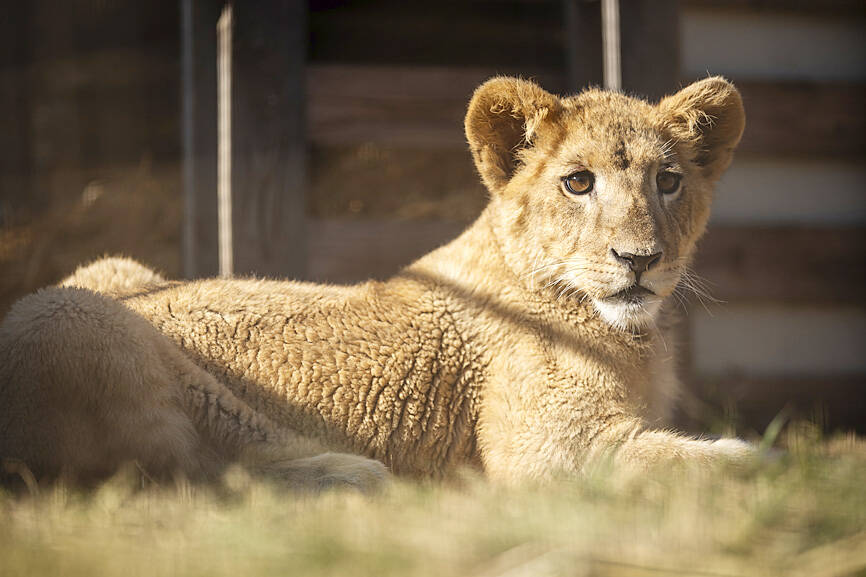Freya, a six-month-old lion cub rescued from the wildlife trade in Lebanon, poked a curious nose out of her transport crate and sniffed the air. Satisfied, she took her first cautious steps in her new home in a sanctuary in South Africa.
Freya’s relocation to the Drakenstein Lion Park is only a partial success story.
She can never live as a lion should in the wild. She has been given lifetime sanctuary at Drakenstein, which has taken in other lions from zoos and circuses in Chile, France, Romania and elsewhere. Some have terrible backstories of abuse, shared on placards at the sanctuary: Ares was blind and neglected when he was rescued, while Brutus had been beaten hard enough to break his jaw.

Photo: AP
However, as Freya settles in at Drakenstein, animal welfare groups have again drawn attention to South Africa’s contradictory position when it comes to the species that often symbolizes African wildlife.
South Africa, with an admirable reputation for conservation and ethical sanctuaries such as Drakenstein, also has a thriving captive lion business where the big cats are bred for petting and other encounters, but also for killing in “canned hunting” experiences or for the lion bone trade.
South Africa has special permission through the Convention on International Trade in Endangered Species of Wild Fauna and Flora to export lion bones and skeletons, mostly to Southeast Asia to be used in traditional medicines. Canned hunting, where lions are chased down and shot in enclosures with no chance of a fair chase or escape, is also legal.
Animal welfare groups have pushed for the business of breeding lions in captivity to end. The South African government recently announced that it plans to close down the industry, and it is expected to take two to three years if there are no legal challenges.
It has been a stain on South Africa’s conservation brand, said Audrey Delsink, the Africa wildlife director for Humane Society International, which was involved in Freya’s relocation. She said it was important for people to realize that the cute cubs used for petting encounters at some South African parks — but not at Drakenstein — end up being big lions shipped off to be killed.
“They’ve been pulled from their mothers, they’ve been hand-raised for you to take selfies with and enjoy them, and then eventually the same lions are going to be shot for trophies in a camp from which they cannot escape, and then end up as a bag of bones,” Delsink said.
There are more than 300 captive lion facilities in South Africa, with more than 7,000 lions. That is double the number of lions in the South African wild. Campaigners against the business say it should be made more clear to visitors that the vast majority of South Africa’s lions live in cages in the world’s largest captive lion industry.
“We cannot pull the wool over tourists’ eyes anymore,” Delsink said.
As for Freya, her rescuers hope that she will eventually bond and live in the same enclosure as young male cub Pi, who they believe is her brother and was brought from Lebanon in April.
Pi was illegally trafficked and owned by a man who used him to promote his TikTok account, said Jason Mier, director of Animals Lebanon, which rescued Pi and Freya.
Pi often had his mouth taped shut when used for videos or selfies and was locked in a small cage at night.
He was kept as a status symbol for his owner “to be able to show off I’m powerful, I have money, look at me,” Mier said.
Freya and Pi are the latest among nearly two dozen big cats to be rescued by Animals Lebanon. Some have come to Drakenstein, which does not allow cub petting or any close encounters, but does welcome visitors to watch the lions and learn about them.
Freya and Pi would not survive if released in the wild, so the sanctuary is the best option for them.
Those involved in Pi’s rescue said they remember watching the cub experience grass under his paws for the first time at Drakenstein, even if it was in the enclosure he and Freya are likely to inhabit for the rest of their lives.

Brazil, the world’s largest Roman Catholic country, saw its Catholic population decline further in 2022, while evangelical Christians and those with no religion continued to rise, census data released on Friday by the Brazilian Institute of Geography and Statistics (IBGE) showed. The census indicated that Brazil had 100.2 million Roman Catholics in 2022, accounting for 56.7 percent of the population, down from 65.1 percent or 105.4 million recorded in the 2010 census. Meanwhile, the share of evangelical Christians rose to 26.9 percent last year, up from 21.6 percent in 2010, adding 12 million followers to reach 47.4 million — the highest figure

A Chinese scientist was arrested while arriving in the US at Detroit airport, the second case in days involving the alleged smuggling of biological material, authorities said on Monday. The scientist is accused of shipping biological material months ago to staff at a laboratory at the University of Michigan. The FBI, in a court filing, described it as material related to certain worms and requires a government permit. “The guidelines for importing biological materials into the US for research purposes are stringent, but clear, and actions like this undermine the legitimate work of other visiting scholars,” said John Nowak, who leads field

‘THE RED LINE’: Colombian President Gustavo Petro promised a thorough probe into the attack on the senator, who had announced his presidential bid in March Colombian Senator Miguel Uribe Turbay, a possible candidate in the country’s presidential election next year, was shot and wounded at a campaign rally in Bogota on Saturday, authorities said. His conservative Democratic Center party released a statement calling it “an unacceptable act of violence.” The attack took place in a park in the Fontibon neighborhood when armed assailants shot him from behind, said the right-wing Democratic Center, which was the party of former Colombian president Alvaro Uribe. The men are not related. Images circulating on social media showed Uribe Turbay, 39, covered in blood being held by several people. The Santa Fe Foundation

NUCLEAR WARNING: Elites are carelessly fomenting fear and tensions between nuclear powers, perhaps because they have access to shelters, Tulsi Gabbard said After a trip to Hiroshima, US Director of National Intelligence Tulsi Gabbard on Tuesday warned that “warmongers” were pushing the world to the brink of nuclear war. Gabbard did not specify her concerns. Gabbard posted on social media a video of grisly footage from the world’s first nuclear attack and of her staring reflectively at the Hiroshima Peace Memorial. On Aug. 6, 1945, the US obliterated Hiroshima, killing 140,000 people in the explosion and by the end of the year from the uranium bomb’s effects. Three days later, a US plane dropped a plutonium bomb on Nagasaki, leaving abut 74,000 people dead by the